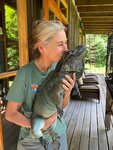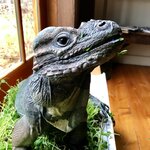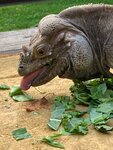CALLICOON, NY — Wendy Townsend’s morning starts with a little writing before the iguanas wake up.
“Then I’ll look across the room and see Emo,” Townsend said. …
Stay informed about your community and support local independent journalism.
Subscribe to The River Reporter today. click here
This item is available in full to subscribers.
Please log in to continue |



CALLICOON, NY — Wendy Townsend’s morning starts with a little writing before the iguanas wake up.
“Then I’ll look across the room and see Emo,” Townsend said. “He’ll be really focused on me. On what will happen, on my emotional intentions.”
It’s a survival mechanism, she said. So she pets him, makes contact. Reminds him that she is his human, maybe.
“If I don’t tend to him, he’ll get frustrated and bite,” Townsend said.
Not all iguanas like physical contact, but Emo does. Each of her iguanas is different. They are their own people, and they are her people, a deep connection that goes back to Townsend’s childhood.
“I arrived on the planet in love with iguanas,” she said.
Not that iguanas were thick on the ground in the Midwest, where she is from. But there was a bullfrog; then there was a lizard. And from such discoveries a life, a pathway, can emerge.
“He was a five-lined skink, and I named him the Hot Weather Lizard,” Townsend said of that first lizard. “I gravitated to bugs, lizards, snakes… They were my people, the way they lived in time and space.”
And then she and her mother moved to lizardless New York City when Townsend was seven years old. Wait: that’s not right. There were iguanas—in pet shops. Far from their home in the West Indies.
“They’re intelligent, and they were looking at me from inside these glass tanks,” Townsend said. “They’d been taken from their home as I had been taken from my home.”
Townsend got her first iguana when she was eight. Later came the apartment in Los Angeles that “was crawling with rescued iguanas. They had malnutrition, fractures, metabolic bone disease.”
She cared for them all, loved and learned.
Townsend wrote a care sheet on iguanas, then a book with Dr. Fredric Frye (“Iguanas: A guide to their biology and captive care”). There have been several books since then: love, life, young people finding their way. Almost always, there were iguanas.
She joined the fight to save Jamaican iguanas, and became fascinated with how “people of diverse backgrounds can find a path in conservation work. These groups are dedicated to working with people, the resources belonging to them and to the planet.”
Then came the conservation-focused Iguana Specialist Group; in 2023, Townsend traveled to Guatemala for the group’s annual conference.
Members are Ph.Ds, biologists, herpetologists. And Wendy Townsend, who has an MFA in writing but who has spent her life with lizards.
Not all species of iguana are endangered—in Florida, greens are practically invasive. Not so others: Bahamian iguanas. Pink iguanas. And the rock iguanas from Hispaniola, a few of whom live with Townsend and her husband Mark Keoppen in Callicoon.
Rock iguanas—the folks who live in Townsend’s barn—come from the West Indies, where it is actually and reliably warm.
But a friend in Florida had recreated the flora and fauna of the Caribbean on his land and settled iguanas there.
“You walk on this amazing property, and nestled on it are these iguana pens, large, 40 feet by 40 feet each. I sat in there with nine rhino iguanas, and it made me enormously happy. They were just being their lizard selves.”
So she and Keoppen set about creating a lizard home in their Callicoon barn house. From the friend came Sebastian, Luna and Che. Ava and Emo arrived later.
By 9:30 a.m., everyone’s up and about. “Ava has climbed down [from her hiding space, or hide] and is ready for breakfast,” Townsend said.
In the summer, all the lizards bask in the sun, safe in large, specially constructed cages. Iguanas are not predators, and back in the islands, some creatures will hunt them.
Exercise is encouraged. “Right now, they’re all middle-aged,” she said. “They’re 20 to 24 years old, and I’m trying to get them to exercise.
“Sebastian wants to roam the house. He’s all about roaming and seeking”; in fact, it improves his state of mind to wander for a while, she said, although it sounds like he’d enjoy owning the house and allowing the humans to live there.
Otherwise, “we tend to their needs and supervise social interaction,” Townsend said. (Learn more at “Lizard life,” above, or on Townsend’s website, lizardlady9.com.)
Spend enough time with iguanas and you can read them. The lizards communicate with their bodies. “There’s a lot going on with eye contact, head bobbing, color changes, standing up to make themselves larger,” Townsend said. It comes down to well over 100 different gestures—“the iguana alphabet.”
“Your whole life, you want to belong,” Townsend said. You want to find your people.
Sometimes those people are iguanas, and sometimes they’re human beings—say, people involved in iguana conservation. “People who share that primal passion” for iguanas, for caring.
“Life would be simpler without iguanas,” she concluded. “And it wouldn’t be any good at all.”
Some information came from the International Iguana Foundation.
Comments
No comments on this item Please log in to comment by clicking here